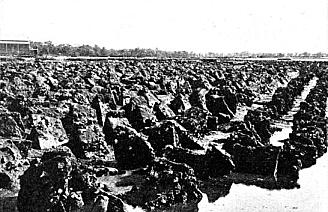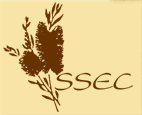Early Enterprises |
Oyster Industry
Fishing and oyster farming are the only pioneer industries surviving in the Shire today. The mud oyster was not the only oyster sought for the Sydney palate. The native estuary oyster that covers the tidal rocks and mangrove roots has an even more delicate flavour than the mud oyster. In 1811 a fisherman named Turpin added bags filled with Georges River and Weeney Bay estuary oysters to his catch when he sent it to market. By the 1830s oyster gatherers in the Georges River and various Kurnell bays provided the main supply to the Sydney market. Indiscriminate harvesting of both mud and estuary oysters prompted the Government to impose a total ban on harvesting all oysters for three years from 1870.
Farming the estuary oyster had its Australian birth with Thomas Holt's experiments. In 1856 he saw an advantage in cultivating rather than just harvesting oysters. While touring the Continent in 1863 he inspected the oyster culture industry in France and consulted world experts on the subject. When he returned to Australia in 1864 he bought Gwawley Bay for the sum of 80 and Weeney Bay for100. He then procured the services of 200 convicts to customise his bays. Gwawley was to be the spawning area and Weeney the maturing area. They shored up the banks of Gwawley Bay with tree trunks and dug 300 claires (channels) totalling 30 miles in that bay. Then they erected a bridge across the mouth of the bay to Taren Point and put in floodgates to control the level of the water. The claires were filled with oysterlings (immature oysters) from Woolooware Bay, Georges River and Oyster Bay. But the venture proved an expensive failure. It fell victim to the turbidity (muddiness) of Gwawley Bay's water which, together with the excessive temperatures of the rock-hindered water in summertime and the predations of a red worm, served to destroy the unfortunate oysters.
At the expiration of the three-year ban, tenders were called for the lease of the whole of Botany Bay and its tributaries. Mr A. Emerson was the successful applicant. He re-sited undersized oysters to Weeney Bay for maturing. By 1920 there were 40,000 sandstone slabs at Towra and 450,000 at Pelican Point and Stinkpot Bay for the spats (oyster spawn) to cling to. In later years oyster farmers began to use logs, and later elevated wooden racks, to collect the drifting oyster spats.
Fred Sellman owned Bonna Point and Shell Point oyster leases until the 1950s when he handed his holdings over to the Council because he couldn't afford payment of the Council rates. |

 |
| Thirty years ago some of the Bay's fish began to show red spots. It has now been established that Red Spot is directly linked to acid sulphate. So excessive levels have been present in Botany Bay for many years! Dredging began in the Georges River in the late 1950s, and the kelp/seaweed harvesting industry operated from the early 1930s through to the 1960s. Today 60 per cent of the Botany Bay-Georges River oyster industry is in the bays around Towra Point. Quibray Bay has the last mass stand of Posidonia australis seagrass, the deepwater seagrass that oxygenates the water. It is the only place where oysters can safely be set to depurate (purify). |
| top of page |



